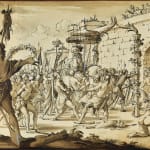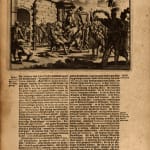
Pieter van der Aa (ed.), De Aanmerkenswaardigste en Alomberoemde Zee-en Landreizen der Portugezen, Spanjaarden, Engelsen, en Allerhande Natiën [...], vol. 4, The Hague and Leiden, 1727, p. 191. (p. 85 of the chapter Vyf Verscheyde Reys-Togten [...] ).
Jan Goeree (Middelburg 1670 - 1731 Amsterdam)
Jan Goeree was born in Middelburg in 1670. His father, Willem Goeree, was a book dealer. When Jan was very young, the family moved to Amsterdam; Jan would remain active there until the end of his life. After studying with Gerard de Lairesse, he became an engraver and a poet. Several of his engravings feature city houses and interiors in Amsterdam. In 1705 he was commissioned to provide the designs for the vault paintings of the Amsterdam City Hall’s great hall.
Goeree also designed many title pages and book illustrations; the present work is a beautiful example of the latter, as it is a design for an illustration in the fourth volume of Pieter van der Aa's De Aanmerkenswaardigste en Alomberoemde Zee-en Landreizen der Portugezen, Spanjaarden, Engelsen, en Allerhande Natiën [...] (The Hague and Leiden, 1727; see ill.). Goeree supplied many designs for illustrations for this enormous work, which consisted of 8 heavy tomes. Some of these designs have come on the market in the past twenty years, although almost never correctly identified.
De Aanmerkenswaardigste en Alomberoemde Zee-en Landreizen was edited and co-published by Pieter van der Aa, known for his ambitious projects. Whereas other publishers were primarily concerned about profit, van der Aa wanted to publish outstanding books. For the present series of travels he either reused and revised older Dutch translations or had the original accounts translated for the first time into Dutch. Interestingly, the drawing - like others Goeree did for this project - was done on the back of part of a print, showing an architectural fragment relating to the French king Louis XIV. To which book or print the fragment pertains however has not yet been established.
Provenance
Sale, van Stockum, The Hague, 11 February 1936;
Private collection, France.


